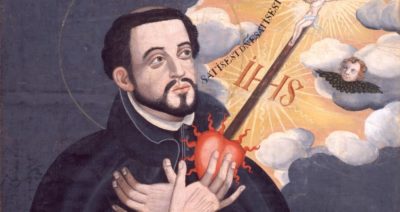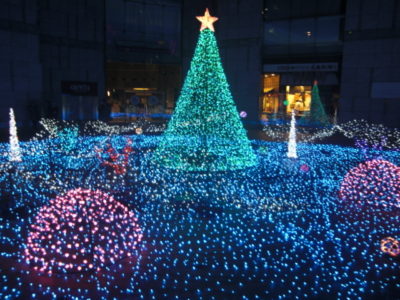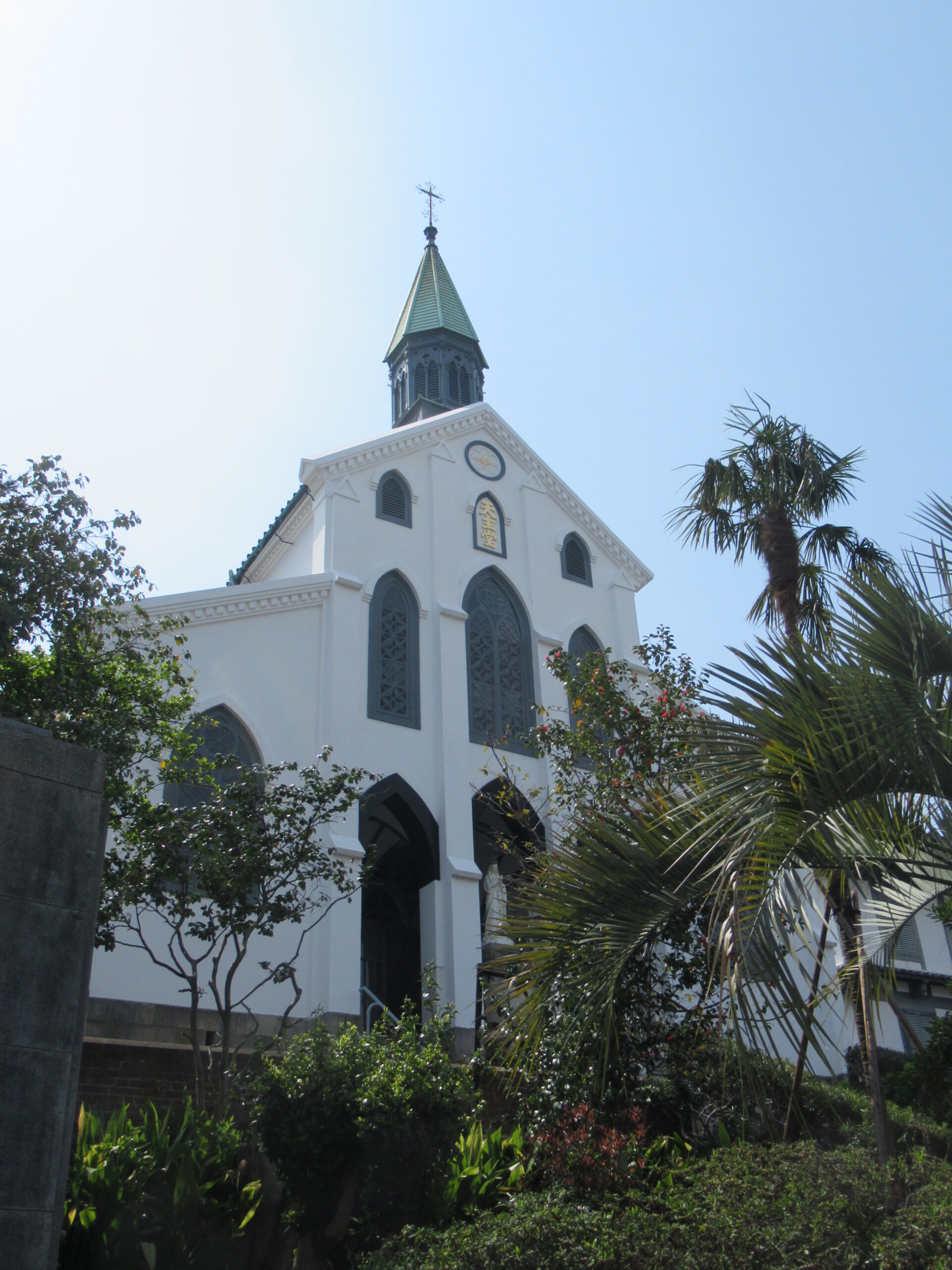Japan’s main religions are Shinto and Buddhism, but did you know that a small part of the Japanese population (1%) are Christians? The reason for this can mainly be found in Japan’s history with Portuguese missionaries. But this is not the only Christian influence to be found in Japan, as once Halloween has come and gone, you will find all kinds of Christmas decorations all over Japan. This new crossover has its roots in the post-war and commercialized import of American culture. Let’s find out more about Christianity in Japan!

Portuguese Missionaries and the Shogunate
Christianity was brought to Japan in 1549 by Francisco Xavier, who was sent there as a Portuguese missionary. It was around the same time when the first gun was brought into Japan by the Portuguese. The 16th century was the Age of Discovery, and also the time when the Jesuits tried to spread Catholicism to combat the religious reform movement in Europe.
This combination made it only logical that Christianity would also one day arrive on the shores of Japan. Xavier was mainly active in Hirado (Nagasaki) and Yamaguchi. He managed to convert a few feudal lords, who in turn helped his activities so Christianity started to spread around Nagasaki.
Oda Nobunaga was the leader of a group of samurai who wanted the unification of Japan in the late 16th century. He accepted the activities of the missionaries, but when Toyotomi Hideyoshi became the leader he expelled them. There were several reasons for that; firstly, he was afraid that Japan might become a colony of the European countries like so many other Asian countries already had at that time.
Christian Rebellion
Secondly, he wanted to have all the power to himself, and a foreign religion was the last thing he could use if he wanted to establish that. And thirdly, he got angry about the fact that some Japanese people were sold as slaves by the Europeans. Also, some missionaries dismantled Shinto shrines and Buddhist temples, making them even less popular with Toyotomi and his followers. To set a strong example, 26 Catholics were executed by crucifixion by Toyotomi Hideyoshi in 1597.
From 1603, Tokugawa Ieyasu took the power and became Shogun. The Tokugawa Shogunate gradually prohibited Christianity, because the idea in Christianity that all people are equal is against the hierarchal ideas of the Shogunate, and if the missionaries would increase their activities, it would mean that the government loses control over the population.
There was a big civil war called the Shimabara Rebellion that occurred in 1637, in which the Christian population rebelled against the shogunate because they wanted to stay Christian. It is said that about 37,000 people in Shimabara (Nagasaki) joined this rebellion, and almost all Christians died either during the fight or by means of execution after the fight was over.
Seclusion Policy: What Happened to Christianity?
In 1639 Japan closed the country for nearly all foreigners, seclusion that eventually lasted more than 200 years. The policy meant that Japan stopped trade with all European countries in order to stop Christianity, except for the Netherlands after the Dutchmen promised that they would never spread Christianity in Japan. The shogunate controlled the trade by limiting their business activity to a small artificial island called Dejima in Nagasaki.
To stop the Japanese people from believing in Christianity, the shogunate made two rules. The first rule was that everyone needed to register at a Buddhist temple as a worshiper. The second rule was that everyone needed to step on an image of Jesus Christ or the Virgin Mary to prove that they were not Christians. After implementing these rules, it looked like Christians had completely disappeared from Japan.
That was, however, not really the case because many Christians continued their belief in secret. They stepped on the icon pretending that they were not Christians, but at the same time, they kept statues of Jizo or Kannon (the goddess of mercy in Buddhism), regarding it as Virgin Mary. They were regarded as hidden Christians. The novel ‘Silence’ by Endo Shusaku explained this very well. This novel was also made into a movie by the director Martin Scorsese.
Opening Up Japan
In 1853, American Commodore Mathew Perry came to Japan with his (in)famous black ships to ask the Japanese to open up the country for trade with the Americans. They came to Japan because they were looking for a port to refuel for their ships, mostly for the purpose of whaling. Besides, the Americans were looking for a base close to China. Under quite some pressure because of the far superior modern weapons of the US, Japan decided to open up the country after 200 years of seclusion in 1854.
Japan also made a treaty with Britain, France, the Netherlands, and Russia. From that point, many westerners came to live in Japan to start a business. Missionaries also came to Japan again, even though Christianity was still prohibited for the Japanese. The westerners who lived in Japan were allowed to be Christian, so they were allowed to build churches for those westerners.
Surprisingly, when they built a church in Nagasaki, a lot of hidden Japanese Christians appeared. It turned out that they passed down Christianity from generation to generation for more than 200 years in secret! After the shogunate finished, the new Meiji government finally accepted Christianity in 1873.
Christianity Brought Japan Historical Churches
Because of its history with hidden Christians, Nagasaki’s population is around 4% Christian while only 1% in other parts of Japan are registered as Christian. The oldest existing Catholic church in Japan is Oura Church (its official name is Basilica of the Twenty-Six Holy Martyrs of Japan) in Nagasaki. It is designated as a national treasure and also listed as a World Cultural Heritage site.
It was constructed by a French priest in 1864 while it was still the feudal time in Japan when Christianity was prohibited for Japanese people. This church was therefore built for the westerners who started to live in Nagasaki after Japan opened up in 1854. Nagasaki Port was one of the earliest ports opened to the western world and many westerners, mostly merchants, came to live here.
Other than Oura Church, there are 11 more churches listed as the World Cultural Heritage sites as ‘Hidden Christian Sites in the Nagasaki Region’. These churches are the witnesses of the history of hidden Christians during the Edo Period when Christianity was prohibited. They found a lot of Christians around the churches when they were built in the late 19th century.
Church Weddings: Are They Christianity Related?
Fast forward to the 21st century, and a very interesting phenomenon has popped up in Japanese weddings. Besides the solemn Shinto or Buddhist ceremony, many couples also opt to have a ‘church’ or chapel wedding. Fake churches and chapels have popped up all over Japan, usually in picturesque locations with a nice backdrop for the pictures. The sole purpose of these venues is to let couples get married in a church-like setting, so the wedding looks like the ones you see in American movies.
While only 1% of the total population in Japan is Christian, many couples opt for a Christian-style wedding in these special locations. The ceremony doesn’t have much to do with religion, but you can bet that it looks picture perfect with the perfect dress and the perfect cake, and especially the ladies tend to dream about a wedding in this style. You can compare it a bit with Vegas’ wedding industry, and from a commercial point of view, it makes perfect sense, as the Japanese wedding industry is good for trillions of yen every year, despite a shrinking younger generation.
Christmas in Japan

The western-style wedding industry isn’t the only Christian tradition that found its way into Japan’s modern traditions; Christmas has become a pretty big deal in Japan in the last 30 years or so. If you come to Japan in November or December, you will find many Christmas trees, Christmas decorations, and Christmas illuminations all over Japan. Children believe in Santa Clause, and they receive presents on Christmas morning. One part of the Christmas tradition that didn’t make it to Japan is the Christmas Eve mass, and the Japanese don’t go to church on December 24th.
Christmas is a very commercial event in Japan, which is probably best exemplified by KFC’s incredible marketing feat. As Colonel Sanders has a resemblance to Santa Clause and chicken can be a substitute to the traditional Christmas turkey, one brilliant KFC store manager came up with the slogan ‘KFC for Christmas’.
Many Japanese took this to heart, and December became KFC’s best month by far, year in year out. Another branch that profits greatly from the commercialism surrounding Christmas in Japan is the hotel business, the love hotel business in particular. While Christmas is associated with the family in most of the world, in Japan it is very much a couple’s holiday. And spending a romantic night in a hotel is one of Japan’s younger generation’s favorite ways to spend this holiday.
Your Japan Tour
As seasoned Japan experts, we can help you create your perfect Japan tour including guides who can tell you all about the Christian history in Japan and take you to some of the important churches. Contact us to start planning your unforgettable holiday to this fascinating country full of once-in-a-lifetime experiences, culture, history, nature, and delicious food!

